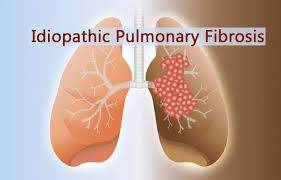Idiopathic Pulmonary Fibrosis (IPF) is a complex and often poorly understood lung disease. Its cause is primarily unknown (idiopathic), but here are some potential factors that can influence the disease, along with signs, effects, and solutions:
**Causes or Factors Associated with Idiopathic Pulmonary Fibrosis:**
1. **Age:** IPF is more common in older adults.
2. **Genetic Predisposition:** Some genetic factors may increase susceptibility.
3. **Environmental Exposures:** Prolonged exposure to dust, pollutants, or certain chemicals.
4. **Occupational Exposures:** Such as asbestos, silica, or farming-related exposures.
5. **Microbial Infections:** Some infections may trigger or exacerbate IPF.
6. **Gastroesophageal Reflux Disease (GERD):** Chronic acid reflux may be a factor.
7. **Smoking:** Although not a direct cause, it can increase the risk.
8. **Male Gender:** IPF is more common in men.
9. **Cigarette Smoke:** Even secondhand smoke exposure can be a risk factor.
10. **Family History:** A family history of IPF may increase risk.
11. **Chronic Viral Infections:** Infections like hepatitis C may be linked.
12. **Autoimmune Diseases:** Some autoimmune disorders can be associated with IPF.
13. **Radiation Exposure:** High-dose radiation therapy to the chest.
14. **Certain Medications:** Some drugs may contribute to lung damage.
15. **Acute Lung Injury:** A severe lung injury in the past may increase risk.
16. **Bone Marrow or Stem Cell Transplant:** A potential complication.
17. **Nanoparticles:** Emerging research on potential exposure risks.
18. **Certain Chemotherapies:** In rare cases, chemotherapy drugs may contribute.
19. **Hypersensitivity Pneumonitis:** Repeated exposure to allergens.
20. **Unknown Factors:** Many cases remain idiopathic, with no clear cause.
**Signs and Symptoms of Idiopathic Pulmonary Fibrosis:**
1. **Progressive Shortness of Breath:** Especially with exertion.
2. **Chronic Dry Cough:** Persistent and unproductive.
3. **Fatigue:** Debilitating tiredness.
4. **Loss of Appetite:** Anorexia.
5. **Unexplained Weight Loss:** Significant and unintentional.
6. **Chest Discomfort or Pain:** Typically mild to moderate.
7. **Clubbing of Fingernails:** Enlarged fingertips and nails.
8. **Fine Velcro-Like Crackles:** Heard with a stethoscope.
9. **Frequent Respiratory Infections:** Due to compromised lung function.
10. **Wheezing:** A whistling sound when breathing.
11. **Cyanosis:** Bluish discoloration of lips and skin in severe cases.
12. **Pulmonary Hypertension:** High blood pressure in the lung arteries.
13. **Depression and Anxiety:** Psychological impact of the disease.
14. **Difficulty Swallowing:** Dysphagia in advanced stages.
15. **Swelling in the Lower Extremities:** Peripheral edema.
16. **Sleep Disturbances:** Due to nighttime symptoms.
17. **Joint Pain:** In some cases of connective tissue diseases.
18. **Hemoptysis:** Coughing up blood in severe cases.
19. **Honeycomb Lung Appearance:** On imaging studies.
20. **Limited Exercise Tolerance:** Due to reduced lung function.
**Effects of Idiopathic Pulmonary Fibrosis:**
1. **Progressive Lung Scarring:** Irreversible fibrosis.
2. **Respiratory Failure:** In advanced stages.
3. **Reduced Lung Function:** Impaired gas exchange.
4. **Heart Strain:** Right-sided heart strain (cor pulmonale).
5. **Pulmonary Hypertension:** High lung artery pressure.
6. **Oxygen Dependency:** Need for supplemental oxygen.
7. **Immunosuppression:** Weakened immune system.
8. **Pulmonary Infections:** Increased susceptibility.
9. **Emotional Distress:** Anxiety and depression.
10. **Malnutrition:** Due to appetite loss and absorption issues.
11. **Fatigue:** Severe and persistent tiredness.
12. **Weight Loss:** Progressive and unintentional.
13. **Cachexia:** A wasting syndrome with muscle and fat loss.
14. **Pleural Effusion:** Accumulation of fluid around the lungs.
15. **Superior Vena Cava Syndrome:** Obstruction of the superior vena cava.
16. **Pericardial Effusion:** Fluid buildup around the heart.
17. **Pneumothorax:** Lung collapse due to scarring.
18. **Hormonal Changes:** Certain lung tumors can produce hormones.
19. **Blood Clots:** Increased risk of deep vein thrombosis and pulmonary embolism.
20. **Death:** Idiopathic Pulmonary Fibrosis can be fatal, especially if diagnosed late or left untreated.
**Solutions for Idiopathic Pulmonary Fibrosis:**
1. **Medications:** Some drugs may slow disease progression.
2. **Oxygen Therapy:** To improve oxygen levels in the blood.
3. **Pulmonary Rehabilitation:** Structured programs for exercise and education.
4. **Lung Transplant:** For end-stage IPF when other treatments are ineffective.
5. **Antifibrotic Medications:** For slowing disease progression.
6. **Vaccination:** Protect against respiratory infections.
7. **Smoking Cessation:** If applicable, quitting smoking is crucial.
8. **Environmental Control:** Reduce exposure to known irritants or allergens.
9. **Nutritional Support:** Maintain a balanced diet for overall health.
10. **Psychological Support:** Counseling or support groups for mental well-being.
11. **Supplemental Oxygen:** Use oxygen therapy as prescribed.
12. **Sleep Hygiene:** Ensure restful sleep despite nighttime symptoms.
13. **End-of-Life Planning:** Discuss and document preferences for care.
14. **Advocate for Research:** Raise awareness and support research efforts.
15. **Clinical Trials:** Explore experimental treatments.
16. **Avoidance of Irritants:** Minimize exposure to pollutants or allergens.
17. **Raise Awareness:** Advocate for research and awareness of IPF.
18. **Palliative Care:** To manage symptoms and improve quality of life.
19. **Physical Therapy:** For symptom management and rehabilitation.
20. **Pain Management:** To alleviate discomfort.


